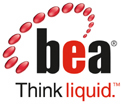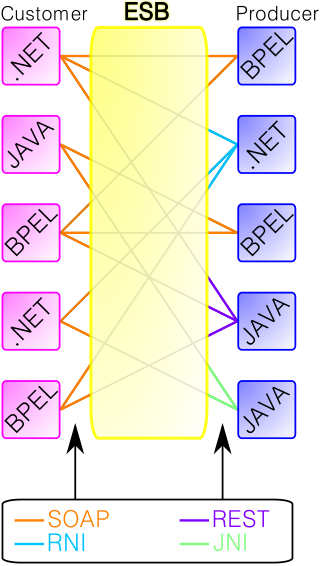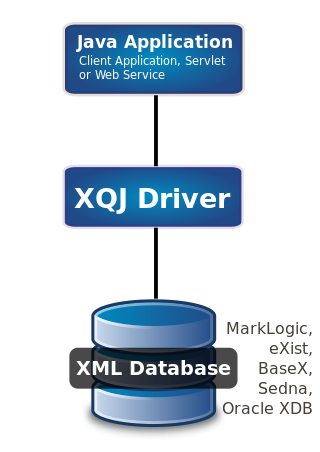Related Research Articles
Structured Query Language (SQL) is a domain-specific language used to manage data, especially in a relational database management system (RDBMS). It is particularly useful in handling structured data, i.e., data incorporating relations among entities and variables.

BEA Systems, Inc. was a company that specialized in enterprise infrastructure software products, which was wholly acquired by Oracle Corporation on April 29, 2008.
In software engineering, service-oriented architecture (SOA) is an architectural style that focuses on discrete services instead of a monolithic design. SOA is a good choice for system integration. By consequence, it is also applied in the field of software design where services are provided to the other components by application components, through a communication protocol over a network. A service is a discrete unit of functionality that can be accessed remotely and acted upon and updated independently, such as retrieving a credit card statement online. SOA is also intended to be independent of vendors, products and technologies.

An enterprise service bus (ESB) implements a communication system between mutually interacting software applications in a service-oriented architecture (SOA). It represents a software architecture for distributed computing, and is a special variant of the more general client-server model, wherein any application may behave as server or client. ESB promotes agility and flexibility with regard to high-level protocol communication between applications. Its primary use is in enterprise application integration (EAI) of heterogeneous and complex service landscapes.
Tuxedo is a middleware platform used to manage distributed transaction processing in distributed computing environments. Tuxedo is a transaction processing system or transaction-oriented middleware, or enterprise application server for a variety of systems and programming languages. Developed by AT&T in the 1980s, it became a software product of Oracle Corporation in 2008 when they acquired BEA Systems. Tuxedo is now part of the Oracle Fusion Middleware.
An XML database is a data persistence software system that allows data to be specified, and sometimes stored, in XML format. This data can be queried, transformed, exported and returned to a calling system. XML databases are a flavor of document-oriented databases which are in turn a category of NoSQL database.
In computing and systems design, a loosely coupled system is one
- in which components are weakly associated with each other, and thus changes in one component least affect existence or performance of another component.
- in which each of its components has, or makes use of, little or no knowledge of the definitions of other separate components. Subareas include the coupling of classes, interfaces, data, and services. Loose coupling is the opposite of tight coupling.
In computing, Oracle Application Development Framework, usually called Oracle ADF, provides a Java framework for building enterprise applications. It provides visual and declarative approaches to Java EE development. It supports rapid application development based on ready-to-use design patterns, metadata-driven and visual tools.
The Oracle Application Server 10g, consists of an integrated, standards-based software platform. It forms part of Oracle Corporation's Fusion Middleware technology stack. The heart of Oracle Application Server consists of Oracle HTTP Server and OC4J which deploys Java EE-based applications. The latest version of OC4J offers full compatibility with the Java EE 1.4 specifications.
Content Repository API for Java (JCR) is a specification for a Java platform application programming interface (API) to access content repositories in a uniform manner. The content repositories are used in content management systems to keep the content data and also the metadata used in content management systems (CMS) such as versioning metadata. The specification was developed under the Java Community Process as JSR-170, and as JSR-283. The main Java package is javax.jcr.
Oracle Fusion Middleware consists of several software products from Oracle Corporation. FMW spans multiple services, including Java EE and developer tools, integration services, business intelligence, collaboration, and content management. FMW depends on open standards such as BPEL, SOAP, XML and JMS.
In computing, Oracle SOA Suite is a part of the Oracle Fusion Middleware family of software products.
Oracle Enterprise Service Bus, a fundamental component of Oracle's Services-Oriented Architecture suite of products, provides integration of data and enterprise applications within an organisation and their connected enterprises.

David R.R. Webber is an Information technologist specializing in applications of XML, ebXML and EDI to standards-based information exchanges. He is a senior member of the ACM since 2007. David Webber is one of the originators of the ebXML initiative for global electronic business via the internet. He is holder of two U.S. Patents for electronic information exchange transformation and those patents are now cited widely by 37 other patents. David Webber has implemented several unique groundbreaking computer solutions in his career including the world's first airport gate scheduling system , the SeeMail email client for MCIMail written in Prolog, the patented GoXML system for XMLGlobal, the ShroudIt obfuscation system for LNK Corp, and the VisualScript tool for Smartdraw Inc.
Service Component Architecture (SCA) is a software technology designed to provide a model for applications that follow service-oriented architecture principles. The technology, created by major software vendors, including IBM, Oracle Corporation and TIBCO Software, encompasses a wide range of technologies and as such is specified in independent specifications to maintain programming language and application environment neutrality. Many times it uses an enterprise service bus (ESB).
Oracle WebLogic Server is a Java EE application server currently developed by Oracle Corporation. Oracle acquired WebLogic Server when it purchased BEA Systems in 2008.
Event-driven SOA is a form of service-oriented architecture (SOA), combining the intelligence and proactiveness of event-driven architecture with the organizational capabilities found in service offerings. Before event-driven SOA, the typical SOA platform orchestrated services centrally, through pre-defined business processes, assuming that what should have already been triggered is defined in a business process. This older approach does not account for events that occur across, or outside of, specific business processes. Thus complex events, in which a pattern of activities—both non-scheduled and scheduled—should trigger a set of services is not accounted for in traditional SOA 1.0 architecture.
EMML, or Enterprise Mashup Markup Language, is an XML markup language for creating enterprise mashups, which are software applications that consume and mash data from variety of sources. These applications often perform logical or mathematical operations as well as present the data.

XQuery API for Java (XQJ) refers to the common Java API for the W3C XQuery 1.0 specification.
Oracle TopLink is a mapping and persistence framework for Java developers. TopLink is produced by Oracle and is a part of Oracle's OracleAS, WebLogic, and OC4J servers. It is an object-persistence and object-transformation framework. TopLink provides development tools and run-time functionalities that ease the development process and help increase functionality. Persistent object-oriented data is stored in relational databases which helps build high-performance applications. Storing data in either XML or relational databases is made possible by transforming it from object-oriented data.
References
- ↑ Hewitt, Eben (2009-03-17). Java SOA Cookbook: SOA Implementation Recipes, Tips, and Techniques. "O'Reilly Media, Inc.". ISBN 978-0-596-55106-3.
- ↑ Schorow, David; Davies, Jeff; Ray, Samrat; Rieber, David (2008-10-21). The Definitive Guide to SOA: Oracle Service Bus. Apress. ISBN 978-1-4302-1058-0.
- ↑ Maheshwari, Arvind; Panda, Debu (2009-12-04). Middleware Management with Oracle Enterprise Manager Grid Control 10g R5. Packt Publishing Ltd. ISBN 978-1-84719-835-8.
- 1 2 "Using the AquaLogic Service Bus Console: MFLs". Oracle. Retrieved 2024-10-21.